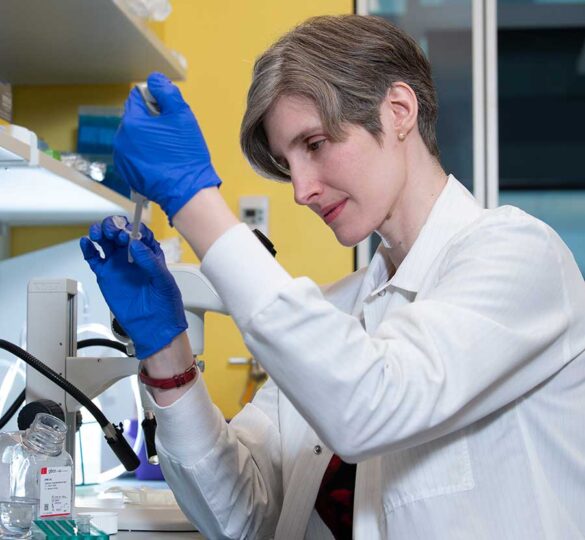2023 Research Progress: Catalyst for a Cure
Glaucoma Research Foundation is dedicated to scientific research that deepens our understanding of glaucoma, generates new treatments, and will ultimately lead to a cure.

Catalyst for a Cure (CFC) is Glaucoma Research Foundation’s flagship research program. We are currently funding two CFC research teams.
CFC3: The Catalyst for a Cure Vision Restoration Initiative is seeking innovative ways to regrow or replace retinal ganglion cells and axons, which make up the optic nerve. The principal investigators are Xin Duan, PhD (UC San Francisco), Yang Hu, MD, PhD (Stanford University), Anna La Torre, PhD (UC Davis), and Derek Welsbie, MD, PhD (UC San Diego).
CFC4: The Melza M. and Frank Theodore Barr Foundation Catalyst for a Cure Initiative to Prevent and Cure Neurodegeneration began their investigations in 2022. The principal investigators are Sandro Da Mesquita, PhD (Mayo Clinic), Milica Margeta, MD, PhD (Mass Eye and Ear), Karthik Shekhar, PhD (UC Berkeley), and Humsa Venkatesh, PhD (Brigham and Women’s Hospital).
The CFC3 Vision Restoration team is pursuing three major goals: 1) develop neuroprotective therapies to halt the progression of vision loss from glaucoma, 2) develop strategies for visual restoration using cell transplantation to replace lost optic nerve cells, and 3) reconnect the eye to the brain to restore visual functions to improve the function of injured optic nerve cells. In the past year, the team has made significant progress on multiple fronts. They have advanced the field of neuroprotection, made important progress with cell replacement research, and identified several exciting candidate targets to improve optic nerve cell survival — all essential next steps that are laying a foundation for vision restoration.
The CFC4 research team is seeking innovative approaches to prevent and cure diseases that occur when key cells in the central nervous system deteriorate and die — a process known as neurodegeneration. Their efforts to date have focused on optimizing a genomic profiling technique called “single cell RNA Sequencing” that they will use to analyze the microenvironment in disease models of glaucoma, Alzheimer’s, and brain tumors. Following a computational analysis of the pilot experiment, they expect to find common cellular and molecular pathways that are altered across the three diseases, with the hope that this information will lead to development of novel therapeutic approaches for these neurodegenerative conditions.
In August 2023, both Catalyst for a Cure research teams participated in a joint Catalyst Meeting along with invited guest research scientists: “Solving Neurodegeneration 2” in Boston, Mass. Inspired by GRF donors Richard and Carolyn Sloane, the goal of the meeting was to bring together specific expertise and knowledge to address barriers and discover novel opportunities to accelerate their research.
Posted on August 16, 2023
Pictured: Milica Margeta, MD, PhD in her laboratory